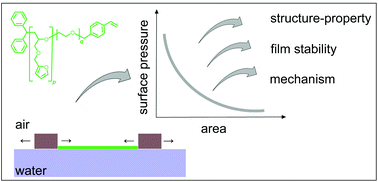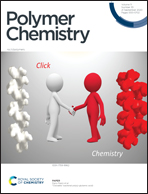Structure–property relations of amphiphilic poly(furfuryl glycidyl ether)-block-poly(ethylene glycol) macromonomers at the air–water interface†
Abstract
To deepen our knowledge of the film formation and the structure–property relations of poly(furfuryl glycidyl ether)-block-poly(ethylene glycol) (PFGEp-b-PEGq) macromonomers at the air–water interface, we synthesized PFGEp-b-PEGq in six different block lengths. The molar mass of the PFGEp-b-PEGq macromonomers varied from ∼2000 g mol−1 to ∼7000 g mol−1 and included a wide range of hydrophilic–lipophilic balance (HLB) values between 3.6 and 13.9. Surface pressure–area (π–A) isotherms of these amphiphilic macromonomers revealed that the block lengths and the molar mass influence the isotherm shape and onset. Smaller, more hydrophobic macromonomers (HLB < 8) showed a steeper surface pressure increase in the liquid condensed phase compared to larger, more hydrophilic macromonomers with HLB > 8. The molecular area for isotherm onsets increased almost linearly with growing molar mass of the macromonomers. Static and dynamic film stability measurements demonstrated limited stability of all macromonomer monolayers at the air–water interface. The more hydrophilic macromonomers PFGE8-b-PEG79, PFGE18-b-PEG66 and PFGE13-b-PEG111 (HLB > 8) showed higher film stability compared to the more hydrophobic macromonomers (HLB < 8). Hysteresis experiments displayed an almost linear increase of the film degradation with rising HLB values of the macromonomers. Due to partial film recovery of our macromonomers, we propose an interplay between a reversible folding and an irreversible submersion mechanism for the macromonomer monolayers at the air–water interface. The molecular structure and the film forming ability of the macromonomers at the air–water interface indicate that they are promising surface functionalization reagents for materials formed from aqueous solutions, such as hydrogels. In this regard, PFGE10-b-PEG9 is the most promising hydrogel surface functionalization reagent, because it can introduce the highest number of functional groups per surface area.



 Please wait while we load your content...
Please wait while we load your content...
